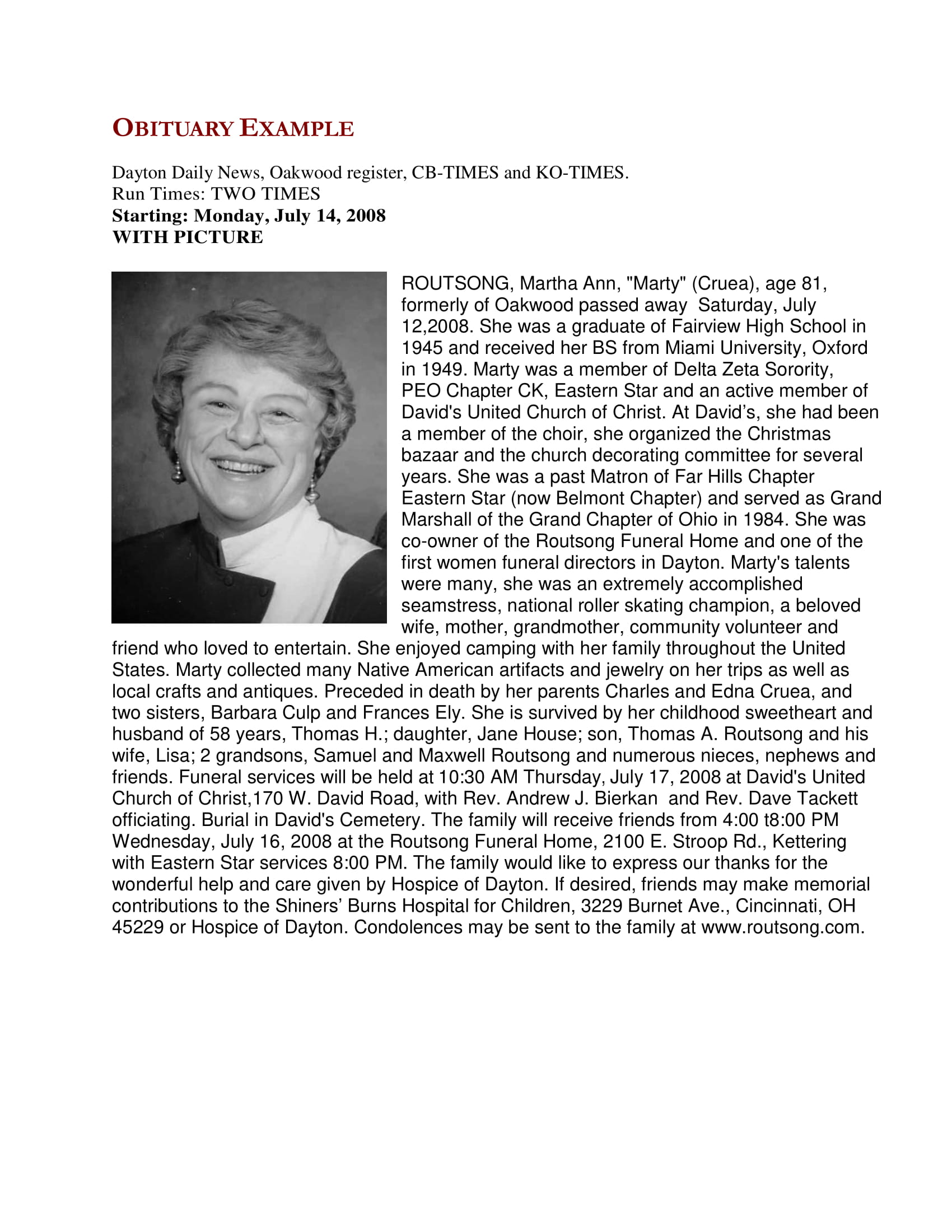Writing a Newspaper Obituary
Writing about the passing of a loved one is never easy in any way or form. It takes a lot from you to even think about losing people you value so much; how much more if you are writing about them in short paragraphs or even short sentences. Although it is very challenging, sometimes we really need to push through the pain.
An obituary or death notice serves as a public acknowledgment of the death of a loved one, an expression of the pain of their loss and the joy they brought while they were still alive. Writing an obituary requires a lot of thought and careful thinking. Aside from reporting the death of a person, obituaries are short articles within a newspaper or an online newspaper that typically includes an account of the person’s life and information about the upcoming funeral – a mini-biography of sorts. You may also see periodic sentences.

However, national newspapers only publish obituaries of significant people or public figures. And, the demand to write for obituaries in local newspapers has decreased since recently it only publishes weekly instead of daily. Because of this, online obituaries have become more popular among the new generation. You may also see How to Write an Obituary & Steps & Examples
Importance of a Newspaper Obituary
Many deny the fact that writing for an obituary is a work of art. As morbid as it sounds as it particularly focuses on death, an obituary is vital and an honorable way of reporting. According to Carlene Hempel, a professor in the School of Journalism in Northeastern University, that the key elements required for writing a beautifully written obituary “is capturing the person in death as he was in life, to really seek out the components of his personality that will come out in the writing.” You may also see obituary writing examples.
An obituary might be the only time that the person’s name appears in a newspaper. And through this, a lifelong record of the person’s life – who their parents were, who their children are, where they’ve been and what they’ve done, is written. It is a tangible representation of the last memory of the person. You may also see Short Eulogy Examples
“People will clip obituaries and save them for years,” Hempel says. “They’ll put them on their fridges, or keep them folded up in their sock drawers. It’s an enduring piece of journalism.” And as any form of journalism goes, it is important to get your facts straight and accurate. You may also see catholic obituary examples.
In the past, obituaries are not news stories and quite frankly, not even profiles. It functions in fill-in-the-blanks rigidity much like the phrasal template word game of Mad Lib. It follows a typical layout, something like this:
I. Lede/Introduction
A. Age of death
B. Cause of death (unless that cause would be inappropriate to state)
II. Career — most notable achievements
A. Prizes, awards, etc.
III. Career — social effects of achievements
A. statistics
B. quotes from colleagues
C. quotes from other experts in the field
D. anecdotes from popular culture
IV. Career — what led to the major achievements
A. anecdote of previous failure(s) before success achieved
V. Career — what followed the major achievements
A. details of later work
B. details of retirement
VI. Family
A. He/she is survived by, etc., etc.
However, just like everything else, writing obituaries has evolved over a period of time and writers have found new ways of writing it. Now, obituaries tell the additional stories, but it is still deeply rooted in the professional, leaving the rest – the personal stuff, the family stuff, implied. With this, obituaries not only serves as a good reading material but as tales of morality, too, ever so subtly guiding human behavior. You may also see obituary for your business.

How to Write a Newspaper Obituary
1. Basic Elements of an Obituary
- Full name of the deceased
- City where they resided
- Surviving family
- Date, time and address of memorial service
- Date, time and address of burial service
- Officiating clergy
- Memorial contributions to be made in lieu of flowers to:
- Photo – if there’s room
2. A Life Lived
While it is important to include the basic information about the person like his/her surviving family and funeral arrangements, it is also important to tell the person’s story in a compelling and interesting way. Focus on the achievements he/she has accomplished and the contributions he/she has made in the community.
It is common that obituaries are dull and rigid because of the fact that the writer has to tailor the obituary to the cost and limit in the newspaper. However, it is not an excuse to undermine the achievements the person had especially when he/she has been a significant person in the community. If you are worried about the newspaper costs that charge by the column inch or the number of column lines, focus on the deceased’s achievements instead of funeral arrangements to keep the word count to a minimum. You may also see simple sentences.
3. Facts to Include
Basic information to include in an obituary is the name and/or nickname of the deceased, the town or city of residence, the place and cause of death, the person’s age and the date he or she died including the year. When writing an obituary, it is important to write his/her date and place of birth and his/her parents.
Include siblings, close friends, and information about the person’s education. Include his/her notable achievements, where he/she worked or his/her business, and his/her charitable advocacies. You may also see exclamatory sentences.
4. Listing Family Members
List the family members in order. In case of limited space, mention the spouse of the deceased first and where they currently reside. List the children in the order they were born together with their spouses, if any, grandchildren, great-grandchildren, parents, grandparents, siblings, cousins, in-laws, nephews or nieces, all listed in birth order. You can also include the deceased’s pets if he/she was particularly fond of pets. You may also see topic sentences.
5. Funeral Arrangements
It is important to include the place, day, time and date of the funeral or memorial service. List the person’s name who officiates the service and the names of pallbearers, if applicable. If the family decides on an open casket viewing, include the dates and times for the viewings. If there are plans for a graveside service, include the site, day, time and date. Also, include the funeral home in charge of arrangements and whom to call for more information about the services planned. You may also see compound sentences.
6. Photo
Although you have to pay an additional fee in order to include a photo of the deceased, it is a gentle reminder of the person you love. Remember that the obituary of your loved one is in a sea of other obituaries and a photo will help people easily recognize the deceased. It is not advised to use really old photos of the deceased as a lot of family and friends may not recognize him/her. You may also see parallel sentences.
7. Finale
If the family wants to set up a donation fund, let people know where they can send their memorial donations by including the address or website in the obituary. Lastly, give thanks to any special people, organizations or groups that were a big help to the deceased. You can also include a favorite poem or quotation of the deceased. You may also see complex sentences.

Tips You Can Follow While Writing an Obituary
1. Keep it Simple and Accurate
Just like any writing tasks, it is better to start an obituary with a draft. Writing a draft ensures that you have included all the needed information about the deceased. The draft also makes it easier for you to fact check and cross-examine the facts you have included. You may also see balanced sentences.
Keep the obituary simple but accurate. Do not include information you’re not so sure about without consulting the family of the deceased. The obituary should appear in the local newspaper of the deceased’s family and friends. Keep the long version to be posted online– online obituaries, personal blog, etc. Write shorter versions for other publications. You may also see negative sentences.
2. Use Compelling Words
Straight facts will tell a story but it won’t compel the readers to finish reading. Use words that show instead of tell. For example, instead of “He served in homeless shelters,” try something like this instead “After retiring from the U.S. Army, he has been actively serving fellow veterans who unfortunately have lost their way. He has founded the Veteran’s Sanctuary in 1995 in order to help former US Army members with their psychological traumas, helped rebuild their lives and give them a place they can call home.” You may also see run on sentences.
3. Proofread, Edit and Revise
Ask for other people’s help in proofreading and editing your piece especially those who are older than the deceased e.g. his/her parent, grandparents, close uncles and aunties, etc. Proofreading will help you avoid and edit errors before publishing the obituary. If necessary, revise the piece after you have sought the approval of the deceased’s family and friends. You may also see preposition sentences.
4. Write in Third Person Narrative
An obituary is not about the people the deceased has left behind, it is all about the person who died. Write it from a third person’s perspective, as an outsider or bystander who witnessed the event. Avoid including yours and the deceased’s preferences when listing family members and friends, this might taint the image of the deceased and that would be the last thing you want people to remember about him/her. Remain consistent with the flow of your piece. You may also see conditional sentences.
5. Research about Newspapers
First, conduct a research to find out what it might cost you before submitting the obituary to newspapers. Ask about the fees, word count and other requirements needed before being able to publish. With all the information you need, you can then tailor your piece to the newspaper’s preference. This will cut you the hassle of countless editing and revision. You may also see interrogative sentences.
obit-example.pdf
When writing an obituary, remember that it might be the last tangible memory the family and friends of the deceased have. Display respect and be sensitive to the family by honoring the deceased through showing and telling how he/she has lived his/her life. Focus on the deceased’s achievements instead of his/her lapses. You may also see cumulative sentences.
Keep the obituary simple but full of life. Just because he/she has died doesn’t mean you strip him/her of value. Celebrate the life the deceased has lived through giving him one last public acknowledgment of the changes he/she has brought about to other people. You may also see imperative sentences.



